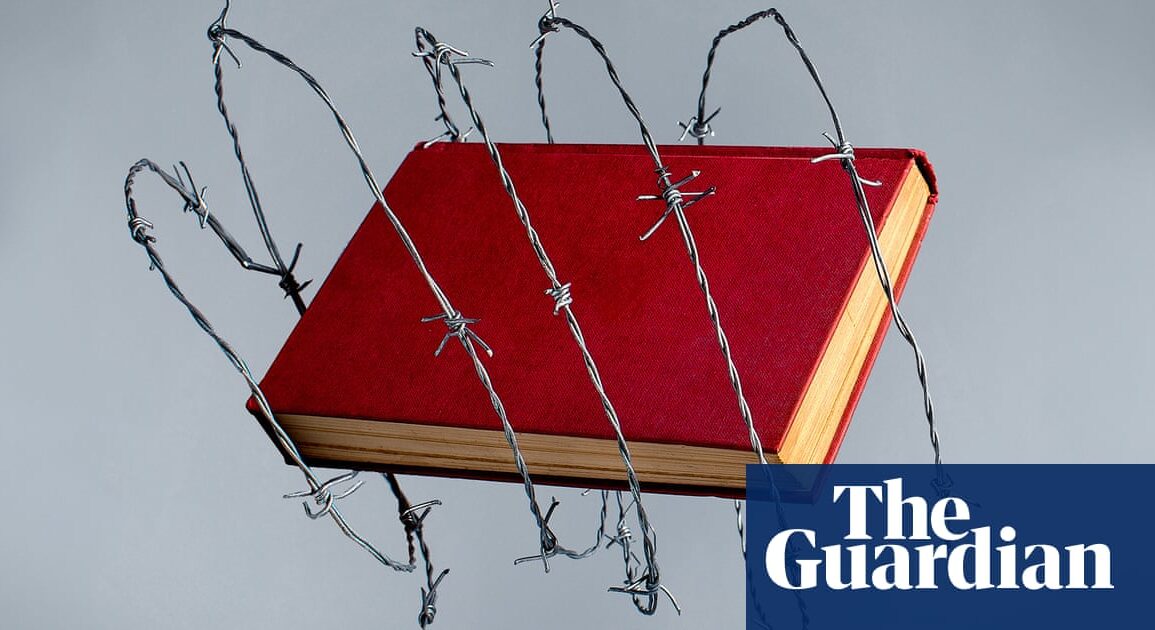
In recent years the issue of book bans has become a major story in the US, often driven by socially conservative pressure groups, but nowhere has the impact of bans been felt more acutely than in America’s enormous prison population, activists and campaigners say.
Books can serve as vital connections to the outside world for incarcerated individuals, yet they are frequently censored in US prisons. Campaigners are advocating for public library catalogs to be accessible on carceral tablets.
“We are adults in these prisons, and we’re told that we can’t read this, we can’t read that, we can’t read this book, we can’t see that article, and we’re like, ‘For what reason?’” Stevie Wilson, who is currently incarcerated in Pennsylvania, told the Guardian.
“We need people out there to know that, and we need them to join us in our fight against censorship.”
Prison Banned Books Week – which has just ended – is one of many initiatives in the past few years that have sought to raise awareness about the rise of literary censorship in the US. While book bans in schools and public libraries are frequently reported on and widely acknowledged, relatively less is known about the extent to which literary censorship affects those imprisoned.
A Marshall Project report originally published in 2022 found that about half of states said they had book policies and lists of banned publications containing over 50,000 titles. Other states don’t keep lists, meaning books can only enter facilities on a case-by-case basis with inconsistent rules and little oversight.
Policies vary widely. The Marshall Project found Florida bans more than 20,000 titles and yet Rhode Island prohibits just 68. Nebraska has a list for only one of its nine prisons, while Wyoming has different lists for each facility. Reasons vary from nudity to depictions of crime or violence to confusing bans that make little sense. Louisiana banned a 700-page book featuring the art of Leonardo da Vinci; Virginia bans World of Warcraft books and Texas banned a visual Spanish-English dictionary.
“Reading is an unmitigated good and should not be restricted,” said Moira Marquis, the founder of Prison Banned Books Week and recent co-editor of Books Through Bars.
“There’s no good reason to limit reading for anyone – let alone incarcerated people.”
Wilson, who said he spends about six hours a day reading and writing, has frequently experienced censorship of reading materials. He described battling the department of corrections for three and a half years and engaging in long appeals processes over accessing certain titles, which often take months and are complex and time-consuming.
“Understand that there are 1,600 people in that prison,” Wilson said, “and 43% of the books that they rejected one year were books that were sent directly to me.”
Next, he plans to order and read The Captive Maternal by Joy James, and A World Without Racism by Joshua Virasami, among others.
Now in its second year, Prison Banned Books Week was sponsored by more than 50 organizations, including the Prison Policy Initiative, the American Civil Liberties Union and the American Booksellers Association.
Organizers also collaborated with the San Francisco public library, which recently made its catalog available to local prisons and jails.
Increasingly, private telecom companies have been contracted to provide tablets in facilities nationwide. However, according to new data, tablets can also be a significant contributor to prison censorship in the US. Not only is the content on them limited, but many prisons and jails charge for access, creating a barrier for incarcerated people to obtain reading materials.
“The per-minute cost to read particularly impacts functionally illiterate readers whose slower pace of reading penalizes them,” said Marquis.
As Marquis has calculated in her research, in New Mexico, for example, it costs 5 cents per minute to read on a prison tablet. That means a 72,000-word book would cost $14.40. As people incarcerated in the state make 10 cents an hour, someone must work many hours to make up that cost.
“While some may think of tablets as an entertainment device or privilege, to incarcerated individuals, they are a rights-accessing platform,” said Zina Makar, a professor whose research examines the carceral system’s impact on the constitutional rights of prisoners.
“Campaigns such as Prison Banned Books Week bring to light the important ways in which incarcerated individuals deeply rely upon meaningful connections with society but also suffer from unnecessary or arbitrary restrictions that are unrelated to the prison’s penological interest of ensuring a safe environment.”
For Megan Posco, who has worked closely with incarcerated writers for years, getting resources into facilities and accommodating this has been challenging.
“I’ve experienced first-hand how onerous it can be to send books and other reading materials, like magazines, into prisons,” she said.
“Though there has been an increased focus on book bans in schools and libraries across the country, censorship in prisons doesn’t inspire similar outcry because of the stigma of incarceration. In truth, prisons are the largest censors in the United States. When speaking out against book bans, it’s essential to remember that incarcerated people are members of our communities.
“Though there has been an increased focus on book bans in schools and libraries across the country, censorship in prisons doesn’t inspire similar outcry because of the stigma of incarceration. In truth, prisons are the largest censors in the United States. When speaking out against book bans, it’s essential to remember that incarcerated people are members of our communities.”
This post was originally published on this site be sure to check out more of their content.









